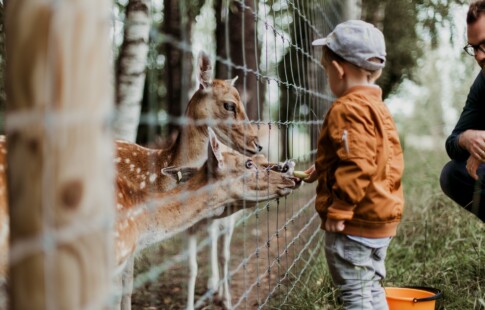
Deforestation’s Effects on Animals
We are reader-supported. When you buy through links on our site, we may earn affiliate commission.
Trees are essential for survival. Without trees, humans wouldn’t have oxygen to breathe, paper products, wood furniture or shade on a hot day. Besides that, trees help purify the air with their leaves and the water with their root systems. They provide people with careers, too.
Animals are also dependent upon trees for survival. A majority of land-based species use the forest as a home. Birds live in trees, and herbivores munch on the leaves or products from some trees, like acorns.
Unfortunately, the forests of the world are under threat by humans. About 30% of the earth is covered in forests, but that number is slowly declining. Besides climate change, deforestation is causing harm to animals that live in the forests and jeopardizes the many benefits forests provide for people.
What Is Deforestation?
Deforestation occurs when humans purposely remove trees from a forested area. There are many reasons for deforestation. Companies may need trees to manufacture various paper products or furniture from wood. Others may cut down trees for agricultural purposes. Clearing an entire section of the forest provides them with an open field to grow food or allow livestock to graze. Even further, people raze forests to build new cities and towns.
This practice has been going on for many centuries. It has drastically altered landscapes throughout the world. Today, much of the deforestation occurs in the tropical rainforests. Sometimes, those who practice deforestation don’t even make use of the trees for products.
What Are the Effects of Deforestation on Animals?
There’s no clear end to deforestation, and it has made a significant impact on wildlife, including habitat loss, starvation, endangerment or extinction, and decreased biodiversity. Here’ are some of deforestation’s effects on animals. Here’s a deeper look at the effects of deforestation on animals and how that impacts our planet.
1. Habitat Loss
One of the primary effects of deforestation is habitat loss. Again, a large portion of land animals relies on the forest as their habitat. It’s where they eat, sleep, breathe and reproduce. When a forest is cleared, it removes the place where populations of animals survive. Deforestation often results in fragmented habitats, which are often unsuitable for survival.
2. Starvation
Further, deforestation can cause animals to starve. Herbivores especially no longer have a source of food. The number of plants and trees decreases as more forested areas are cleared. Unfortunately, animals will begin to die if they can’t find an alternative food source. Once herbivores start to die, carnivores and omnivores won’t have food either.
3. Endangerment or Extinction
Another effect of deforestation on animals is endangerment or even extinction. Animals in highly deforested regions face endangerment and extinction. Due to illegal logging and unsustainable forestry practices, species of orangutans, chimpanzees, gorillas and pandas are endangered because they no longer have a place to live. Soon, these animals may not be able to reproduce, leading to extinction.
4. Decreased Biodiversity
As animals are displaced, and in danger of extinction, biodiversity within a habitat decreases. Biodiversity is essential for an ecosystem to survive. It creates a natural balance between plants, animals, insects and microorganisms. When humans remove thousands of trees from a forest, it decreases biodiversity, leading to further problems that even affect humans. When one species leaves an ecosystem, it destabilizes everything within it.
5. Increased Interaction with Humans
Anytime wildlife and humans interact with one another, it can be a cause for concern. Deforestation often causes habitat loss, which leaves animals in search of a new place to live. Wildlife may begin infiltrating urban areas, and the human response is to get rid of them one way or another. Additionally, deforestation increases the risk of poaching because animals are more out in the open and displaced.
6. Higher Risk of Wildfires and Droughts
Any remaining forested area left after deforestation is more prone to wildfires. Trees help keep the earth cool, and the fewer trees there are, the hotter the earth will become. When there are no trees to maintain the temperatures, the likelihood of droughts and wildfires increases. This often results in desertification when the land becomes barren. Animals cannot survive in these conditions, which causes them to die or try to relocate.
How You Can Help
Although you can’t take a trip to a rainforest or other deforestation-prone area, you can help deforestation reduction efforts at home and work. Below are a few ways to help reduce or eliminate deforestation:
- Use fewer paper products and go paperless with your work. Opt for sending emails and documents online rather than printing them.
- Plant trees wherever possible. This may be in your backyard or local community. Some brands even send money to plant a tree when you purchase a product.
- Support brands that are committed to reducing deforestation.
- Purchase recycled paper and wood products. Make sure you recycle them again!
- Raise awareness and speak out about deforestation.
- Continue to educate yourself on the topic. Education can change the world for you and the wildlife affected by deforestation.
How will you take action today?
Share on
Like what you read? Join other Environment.co readers!
Get the latest updates on our planet by subscribing to the Environment.co newsletter!
About the author
Steve Russell
Steve is the Managing Editor of Environment.co and regularly contributes articles related to wildlife, biodiversity, and recycling. His passions include wildlife photography and bird watching.





